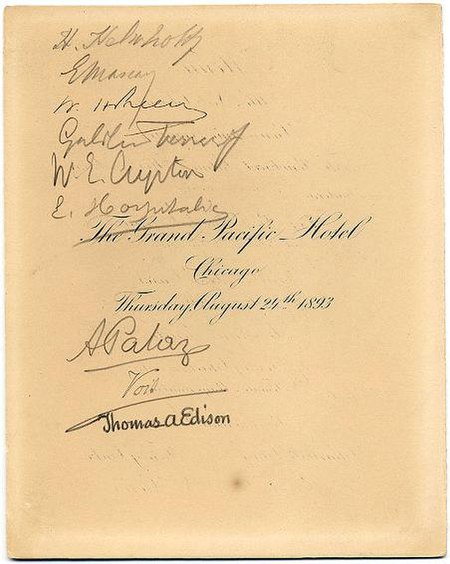File:EdisonGlenmontProvCHICAGO1893rwLIPACKownerB.pdf
EdisonGlenmontProvCHICAGO1893rwLIPACKownerB.pdf (450 × 564 pixels, file size: 665 KB, MIME type: application/pdf)
Captions
Captions
Summary[edit]
| DescriptionEdisonGlenmontProvCHICAGO1893rwLIPACKownerB.pdf |
English: Verso of table card bearing the printed inscription reading: "The Grand Pacific Hotel - Chicago, Thursday, August 24th, 1893," for the world class conclave held in Chicago, Illinois entitled: "Banquet by the American Electricians in honor of the Foreign Official Delegates to the International Electrical Congress."
Card is printed on stiff card stock measuring 5 1/2" x 7" in size. Autographed by several prominent individuals in the electrical world of the day. Participant attendees bearing their signatures include Thomas A. Edison himself, and Elihu Thomson - co-founder of the Edison General Electric Company with Edison. Other prominent attendee signatures include Hermann von Helmholtz. In the years between 1869 and 1871, Helmholtz studied the phenomena of electrical oscillations. On 30 April 1869, in a lecture entitled "On Electrical Oscillations" delivered to the Naturhistorisch-medizinischen Vereins zu Heidelberg (Natural History and Medical Association of Heidelberg) Helmholtz indicated that the perceptible damped electrical oscillations in a coil joined up with a Leyden jar were about 1/50th of a second in duration. In 1871, Helmholtz left the University at Heidelberg for Berlin to become a professor in physics at the University of Berlin. Here at the University of Berlin Helmholtz became interested in electromagnetism and the "Helmholtz equation" is named for him. Although he did not make major contributions to this field, his student Heinrich Rudolf Hertz became famous as the first to demonstrate the principle of electromagnetic radiation. There is even a topic by the name "Helmholtz optics", based on the Helmholtz equation. Dr. A. Palaz, another signatory to the card who actually signed twice, was president of the Consortium des Forces Motrices des Rhone St. Maurice, Valais, Switzerland. Palaz was noted for his work and experiments on the specific inductive capacity of some dielectrics, was a significant contribution to understanding all electrical phenomenon. This work of Palaz further substantiated the initial discovery of same by England's Michael Faraday decades before. This property of the dielectric is called its specific inductive capacity, or the dielectric constant. The difference in value of the specific inductive capacity of any dielectric whereby the ratio of the capacity of a condenser when sulphur is used as the dielectric as opposed to the capacity of the same condenser when air is used - causes a dramatic difference in the capacity of a condenser, and Palaz continued to refine Faraday's work. This card is significant in that it marks the time new electrical advancements were being made by Nikola Tesla and his competative Tesla Polyphase alternating current / "A.C." electrical system was unveiled at the 1893 Columbian Exposition at Chicago concurrently with this electrical industry related dinner held in Chicago - which naturally, Tesla was absent from. Edison and Elihu Thomson, whose General Electric company produced electrical generating systems working in the realm of "D.C." - the direct current mode, certainly realized the threat of the Tesla A.C. electrical system introduced at the 1893 Columbian Exposition at the same time. especially since the Westinghouse Company garnered the distinction of supplying all of the electricity to this World's Fair of 1893. This grouping which Edison and Thomson attended was an effort to aid the cause of the D.C. direct current factions of the day in face of the new Tesla Polyphase A.C. current electrical system which eventually, in soon time, would surpass it. This table card signed by Edison, Thomson, Helmholtz, Palaz and others was discovered by American historian and archivist Richard Warren Lipack in the basement contents he handled from the estate of Thomas A. Edison at Glenmont, Llewellyn Park in West Orange, New Jersey. |
| Date | |
| Source | Own work |
| Author | Richard Warren Lipack |
Licensing[edit]
- You are free:
- to share – to copy, distribute and transmit the work
- to remix – to adapt the work
- Under the following conditions:
- attribution – You must give appropriate credit, provide a link to the license, and indicate if changes were made. You may do so in any reasonable manner, but not in any way that suggests the licensor endorses you or your use.
- share alike – If you remix, transform, or build upon the material, you must distribute your contributions under the same or compatible license as the original.
File history
Click on a date/time to view the file as it appeared at that time.
| Date/Time | Thumbnail | Dimensions | User | Comment | |
|---|---|---|---|---|---|
| current | 07:23, 3 May 2014 |  | 450 × 564 (665 KB) | Richard Warren Lipack (talk | contribs) | User created page with UploadWizard |
You cannot overwrite this file.
File usage on Commons
There are no pages that use this file.
Metadata
This file contains additional information such as Exif metadata which may have been added by the digital camera, scanner, or software program used to create or digitize it. If the file has been modified from its original state, some details such as the timestamp may not fully reflect those of the original file. The timestamp is only as accurate as the clock in the camera, and it may be completely wrong.
| File change date and time | 21:47, 2 May 2014 |
|---|---|
| Date and time of digitizing | 21:46, 2 May 2014 |
| Date metadata was last modified | 21:47, 2 May 2014 |
| Software used | Adobe Acrobat 8.0 |
| Conversion program | Adobe Acrobat 8.0 Image Conversion Plug-in |
| Encrypted | no |
| Page size | 216.96 x 271.92 pts |
| Version of PDF format | 1.6 |
